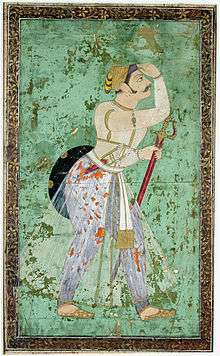Karan Singh II
Karan Singh II[1] (7 January 1584 – March 1628) was the Maharana of Mewar Kingdom (r. 1620 – 1628). He was one of the sons of Maharana Amar Singh I and the grandson of Maharana Pratap. He, in turn, was succeeded by his son Jagat Singh I.. He succeeded his father on 26 Jan 1620 at the age of 36.
| Karan Singh II | |
|---|---|
| Ruler of Mewar | |
 Karan Singh II | |
| Rana of Mewar | |
| Reign | 26 January 1620 – March 1628 |
| Predecessor | Amar Singh I |
| Successor | Jagat Singh I |
| Born | 7 January 1584 |
| Died | March 1628 (aged 44) |
| Issue | Jagat Singh I |
| Father | Amar Singh I |
| Religion | Hinduism |
| Sisodia Rajputs of Mewar II (1326–1884) | |
|---|---|
| Hammir Singh | (1326–1364) |
| Kshetra Singh | (1364–1382) |
| Lakha Singh | (1382–1421) |
| Mokal Singh | (1421–1433) |
| Rana Kumbha | (1433–1468) |
| Udai Singh I | (1468–1473) |
| Rana Raimal | (1473–1508) |
| Rana Sanga | (1508–1527) |
| Ratan Singh II | (1528–1531) |
| Vikramaditya Singh | (1531–1536) |
| Vanvir Singh | (1536–1540) |
| Udai Singh II | (1540–1572) |
| Pratap Singh I | (1572–1597) |
| Amar Singh I | (1597–1620) |
| Karan Singh II | (1620–1628) |
| Jagat Singh I | (1628–1652) |
| Raj Singh I | (1652–1680) |
| Jai Singh | (1680–1698) |
| Amar Singh II | (1698–1710) |
| Sangram Singh II | (1710–1734) |
| Jagat Singh II | (1734–1751) |
| Pratap Singh II | (1751–1754) |
| Raj Singh II | (1754–1762) |
| Ari Singh II | (1762–1772) |
| Hamir Singh II | (1772–1778) |
| Bhim Singh | (1778–1828) |
| Jawan Singh | (1828–1838) |
| Sardar Singh | (1828–1842) |
| Swarup Singh | (1842–1861) |
| Shambhu Singh | (1861–1874) |
| Sajjan Singh | (1874–1884) |
| Fateh Singh | (1884–1930) |
| Bhupal Singh | (1930—1955) |
He engaged with Mughals on many occasions during the life of his father before settlement with Mughals. Later he visited Mughal court many times and learned various aspects of administration. He made several reforms after coming to the throne. Also, palaces were enlarged and defenses strengthened. He presided in relatively peaceful times and Mewar prospered under his rule. He also renovated Ranakpur temple in 1621.
An important event in the Maharana's reign was to extend refuge to Prince Khurram (Shah Jahan) in 1623. In 1622 Prince Khurram raised an army with the support of Mahabat Khan and marched against his father and Nur Jahan. He was defeated at Bilochpur in March 1623. Later he took refuge in Udaipur Mewar with Maharaja Karan Singh II. He was first lodged in Delwada Ki Haveli and subsequently shifted to Jagmandir Palace on his request. Prince Khurram exchanged his turban with the Maharana and that turban is still preserved in (Pratap Museum), Udaipur. (R V Somani 1976).[2]
It is believed that mosaic work of Jagmandir inspired him to use mosaic work in Taj Mahal of Agra. A lot of construction activities are known to have taken place during Rana Karan Singh's reign. He constructed water ditches that ran all along the walls of the Lake Pichola. These ditches received stormwater and overflow from Lake Pichola and conveyed it to Lake Udai Sagar from where the water was used for irrigation. Among the constructions in Udaipur city, he built the Gol Mahal and dome at Jagmandir Island Palace, along with a tank in Krishna Niwas.[3]
References
- "UDAIPUR". Archived from the original on 27 December 2016. Retrieved 16 July 2013.
- "Archived copy". Archived from the original on 2 January 2016. Retrieved 28 February 2017.CS1 maint: archived copy as title (link)
Karan Singh II Born: 7 January 1584 Died: March 1628 | ||
| Preceded by Amar Singh I |
Sisodia Rajput Ruler 1620–1628 |
Succeeded by Jagat Singh II |